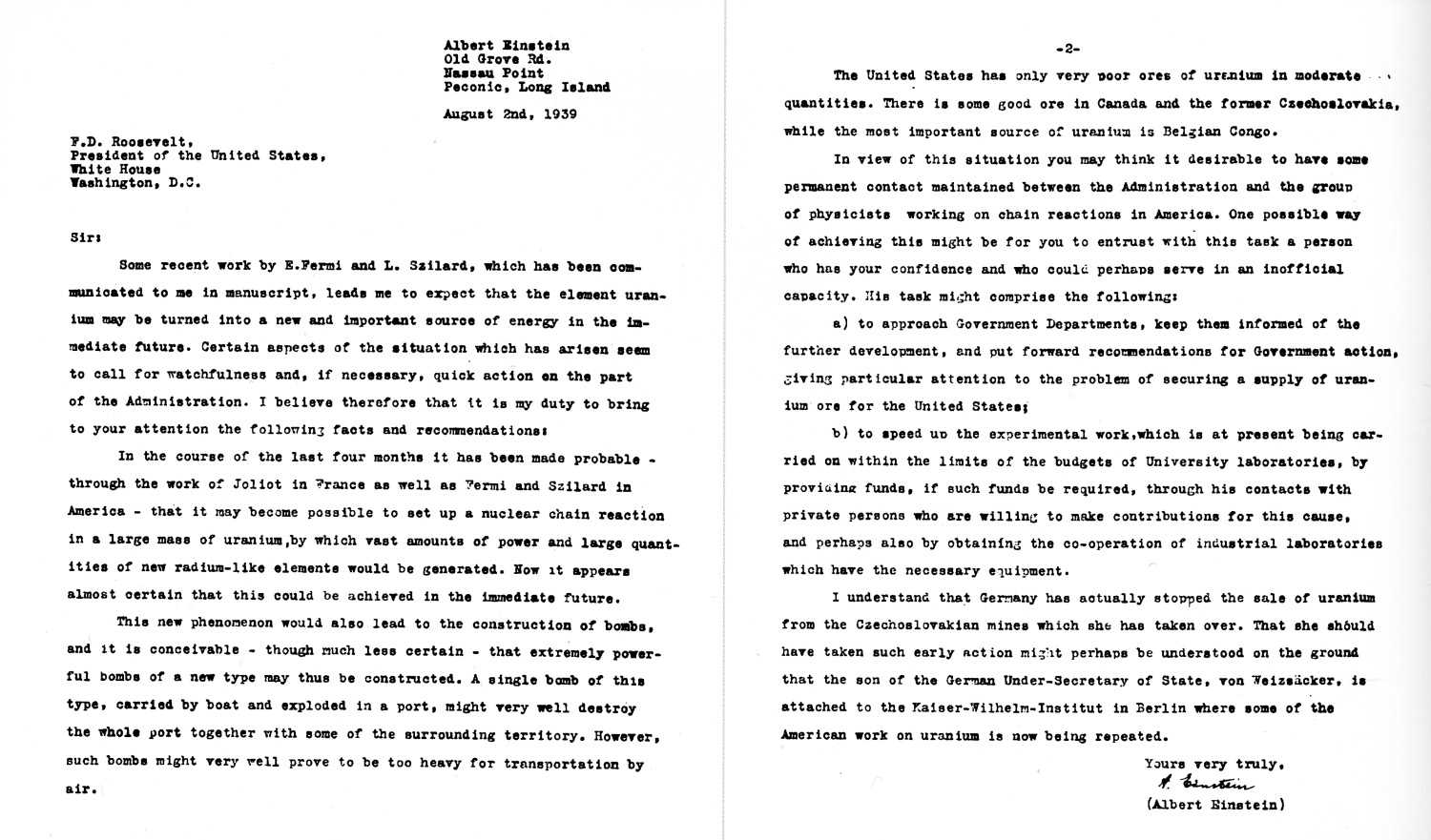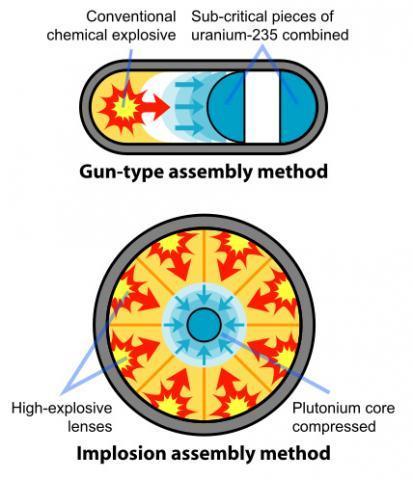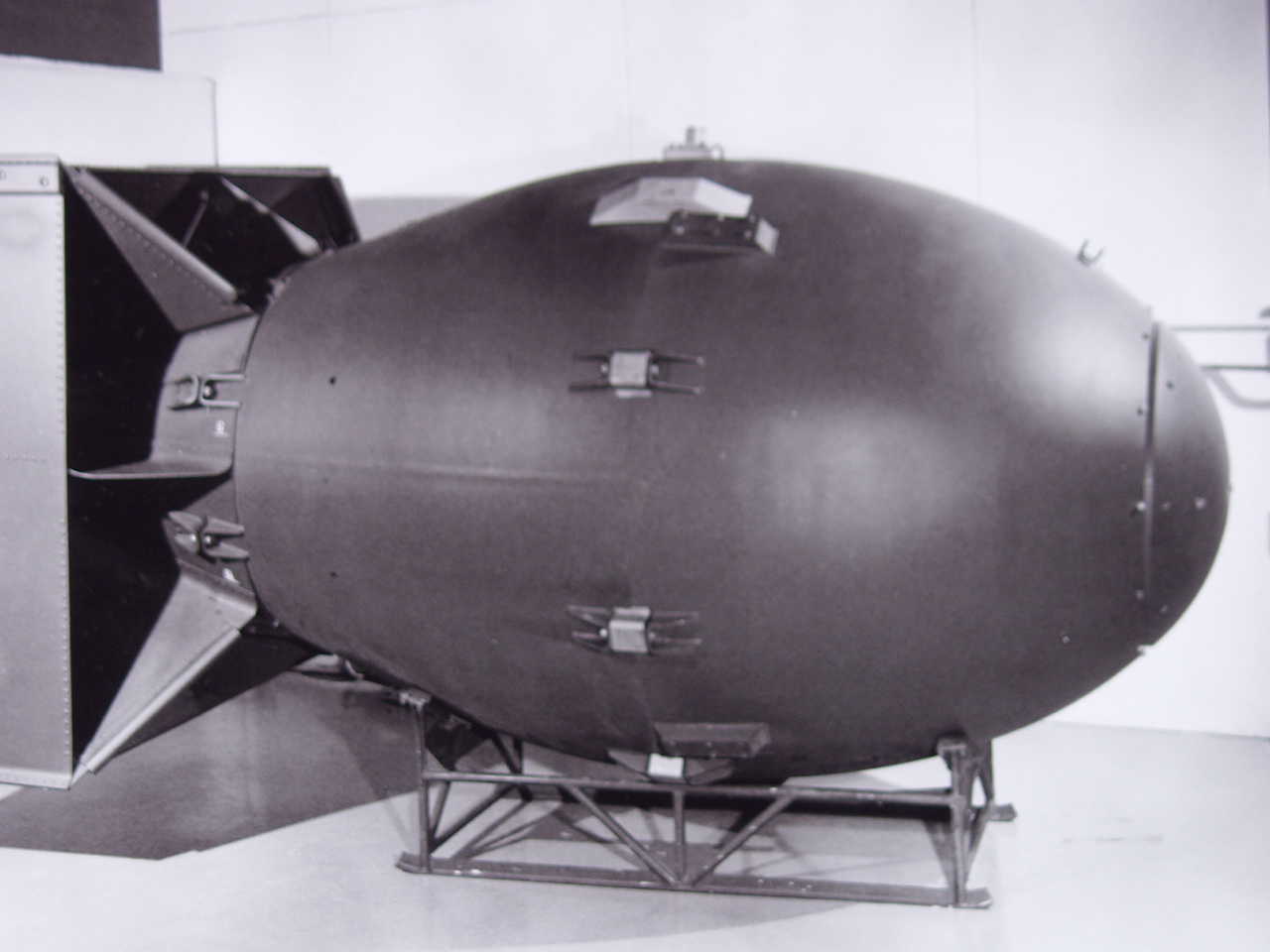




.
The story of the Manhattan Project began in 1938, when German scientists Otto Hahn and Fritz Strassmann inadvertently discovered nuclear fission. A few months later, Albert Einstein and Leo Szilard sent a letter to President Roosevelt warning him that Germany might try to build an atomic bomb. In response, FDR formed the Uranium Committee, a group of top military and scientific experts to determine the feasibility of a nuclear chain reaction.

Einstein-Szilard letter.
Prior to the formal creation of the Manhattan Project, atomic research was ongoing at a number of universities around the United States. At the “Rad Lab” (Radiation Laboratory) at the University of California at Berkeley, research was underway under the direction of Ernest Lawrence. Lawrence’s most significant discovery came with his invention of the cyclotron, known as an “atom smasher,” which could accelerate atoms through a vacuum and use electromagnets to induce collisions at speeds up to 25,000 miles per second. Lawrence believed his machine could separate Uranium-235 by electromagnetic separation, one of the four possible uranium isotope separation methods that would ultimately be considered during the Manhattan Project. Also during this time, Berkeley professors Emilio Segrè and Glenn Seaborg proved that the element 94, which they named plutonium, could also be used in nuclear reactions, offering another possible path to the bomb.
Meanwhile, at Columbia University, a team of scientists, including Enrico Fermi, Leo Szilard, Walter Zinn, and Herbert Anderson, conducted experiments using chain-reacting nuclear “piles” to measure the neutron emission from fission. Production was moved to the Metallurgical Laboratory at the University of Chicago in February 1942. On December 2, Chicago Pile-1 went critical, creating the world’s first self-sustaining chain reaction. The experiment not only proved that nuclear energy could generate power, but also showed a viable method to produce plutonium.
The Manhattan Project’s weapons research laboratory was located at Los Alamos, New Mexico. Under the direction of J. Robert Oppenheimer, the Los Alamos laboratory would conduct the bulk of the remaining research and construction of the bomb. Physicists, chemists, metallurgists, explosive experts, and military personnel converged in the secret town, which grew to be the home of thousands of project workers. Meanwhile, the Army was charged with supplying, supporting, and guarding the top-secret work being done at Los Alamos.

Los Alamos gate 21.
Another important Manhattan Project site was located at Oak Ridge, Tennessee. By this time, the Manhattan Project was pursuing both a uranium and a plutonium based atomic bomb. Oak Ridge was thus the home of the uranium enrichment plants, K-25, Y-12, and S-50, and the pilot plutonium production reactor, the X-10 Graphite Reactor. Equally important was the site at Hanford, Washington, where the full-scale plutonium production plant, the B Reactor, was constructed, and was eventually joined by other reactors.
Dozens of other sites were also involved with the Manhattan Project. In Cambridge, Massachusetts, scientists conducted further research at Harvard University and the Massachusetts Institute of Technology. In Dayton, Ohio, the Manhattan Project tasked the Monsanto Chemical Company with separating and purifying the radioactive element polonium (Po-210), which was to be used as the initiator for the atomic bombs. Even in Canada, the Manhattan Project coordinated its efforts with the Montreal Laboratory and the Chalk River Nuclear Laboratories in Ontario, the site for one of the world’s first heavy water nuclear reactors. Meanwhile, the 509th Composite Group of the Army Air Forces, which would drop the atomic bombs on Japan, trained at Wendover Airfieldin Utah and in Cuba before shipping out to the launching point for the atomic bomb attacks at Tinian Island in the Pacific.
It is estimated that more than 600,000 people worked on the project.
As the Manhattan Project grew closer to producing a bomb, the U.S. government began to consider its wartime options. In May 1945, Secretary of War Henry L. Stimson, with the approval of President Harry Truman, established the Interim Committee to make recommendations on wartime use of the bomb and post-war organization of atomic energy. The committee’s Scientific Panel would issue a report on June 16 recommending the use of the bomb against Japan.
On July 16, 5:29:45 a.m., the atomic age officially began when the world’s first atomic bomb was tested at the Trinity site in the New Mexico desert. The “Gadget” plutonium bomb exploded with approximately 20 kilotons of force and produced a mushroom cloud that rose eight miles high and left a crater that was ten feet deep and over 1,000 feet wide. The Trinity test of the Manhattan Project was the first detonation of a nuclear weapon. The Atomic Age had begun.

Gadget tower.

Trinity test 15.0 s after detonation.
In order to detonate an atomic weapon, you need a critical mass of fissionable material. This means you need enough U-235 or Pu-239 to ensure that neutrons released by fission will strike another nucleus, thus producing a chain reaction. The more fissionable material you have, the greater the odds that such an event will occur. Critical mass is defined as the amount of material at which a neutron produced by a fission process will, on average, create another fission event.

Fission bomb assembly.
On August 6, the United States dropped its first atomic bomb on Hiroshima. Known as “Little Boy,” the uranium gun-type bomb exploded with about thirteen kilotons of force. The B-29 plane that carried Little Boy from Tinian Island in the western Pacific to Hiroshima was known as the Enola Gay, after pilot Paul Tibbets' mother. Between 90,000 and 166,000 people are believed to have died from the bomb in the four-month period following the explosion. The U.S. Department of Energy has estimated that after five years there were perhaps 200,000 or more fatalities as a result of the bombing, while the city of Hiroshima has estimated that 237,000 people were killed directly or indirectly by the bomb's effects, including burns, radiation sickness, and cancer.
Three days later, a second atomic bomb was dropped on Nagasaki – a 21-kiloton plutonium device known as "Fat Man.” It is estimated that between 40,000 and 75,000 people died immediately following the atomic explosion, while another 60,000 people suffered severe injuries. Total deaths by the end of 1945 may have reached 80,000. Japan surrendered on August 14.

Little Boy explodes over Hiroshima, Japan, 6 August 1945 (left); Fat Man explodes over Nagasaki, Jap...
Little Boy was powered by the uranium isotope U-235 in a process that didn’t come easily to the many Manhattan Project scientists working on the uranium extraction and enrichment process. Most uranium found naturally in the world exists as uranium-238, leaving only 0.7% of naturally existing uranium as the U-235 isotope. When a neutron bombards U-238, the isotope often captures the neutron to become U-239, failing to fission, and thus failing to instigate a chain reaction that would detonate a bomb. The first challenge of the project was thus to determine the most efficient way to separate and purify uranium-235 from the overly-abundant uranium-238 - standard methods of separation could not be used due to the strong chemical similarity between the two isotopes. In order to avoid wasting time on one new method that could later prove insufficient to produce enough U-235 to allow the atomic bomb to reach critical mass, General Leslie Groves consulted with lead scientists of the project and agreed to investigate simultaneously four separate methods of separating and purifying the uranium-235: gaseous diffusion, centrifuge, electromagnetic separation and liquid thermal diffusion.
Once enough U-235 was obtained to power the bomb, Little Boy was constructed using a gun-type design that fired one amount of U-235 at another to combine the two masses. This combination created a critical mass that set off a fission chain reaction to eventually detonate the bomb. The two masses of U-235 had to combine with one another quickly enough to avoid the spontaneous fission of the atoms, which would cause the bomb to fizzle, and thus fail to explode.

Little Boy.
Powered by plutonium, Fat Man could not use the same gun-type design that allowed Little Boy to explode effectively - the form of plutonium collected from the nuclear reactors at Hanford, WA for the bomb would not allow for this strategy. The Hanford plutonium emerged from the reactors less pure than the initial plutonium extracted from Ernest O. Lawrence’s Berkeley Lab, instead containing traces of isotope plutonium-240, as opposed to the desired plutonium-239. Plutonium-240’s higher fission rate would cause the atoms to undergo spontaneous fission before the gun-type design could bring two masses of plutonium together, which would lower the energy involved in the actual detonation of the bomb.
Thus, a new design was required. Physicist Seth Neddermeyer at Los Alamos constructed a design for the plutonium bomb that used conventional explosives around a central plutonium mass to quickly squeeze and consolidate the plutonium, increasing the pressure and density of the substance. An increased density allowed the plutonium to reach its critical mass, firing neutrons and allowing the fission chain reaction to proceed. To detonate the bomb, the explosives were ignited, releasing a shock wave that compressed the inner plutonium and led to its explosion.

Fat Man.
Extra videos (warns of shocking scenes):
https://www.britannica.com/technology/atomic-bomb/media/41620/18899
https://www.britannica.com/technology/atomic-bomb/media/41620/128019
https://www.britannica.com/technology/atomic-bomb/media/41620/144861
https://www.britannica.com/technology/atomic-bomb/media/41620/127502
REFERENCES
The Atomic Heritage Foundation. Available in: https://www.atomicheritage.org/history/manhattan-project. Access in: 01/10/2018.
The Atomic Heritage Foundation. Available in: https://www.atomicheritage.org/history/trinity-test-1945. Access in: 01/10/2018.
The Atomic Heritage Foundation. Available in: https://www.atomicheritage.org/history/building-bomb-1943. Access in: 01/10/2018.
The Atomic Heritage Foundation. Available in: https://www.atomicheritage.org/history/science-behind-atom-bomb. Access in: 01/10/2018.
Encyclopædia Britannica. Available in: https://www.britannica.com/technology/atomic-bomb. Access in: 01/10/2018.
Wikipedia. Available in: https://en.wikipedia.org/wiki/Manhattan_Project. Access in: 01/10/2018.

Default timespace